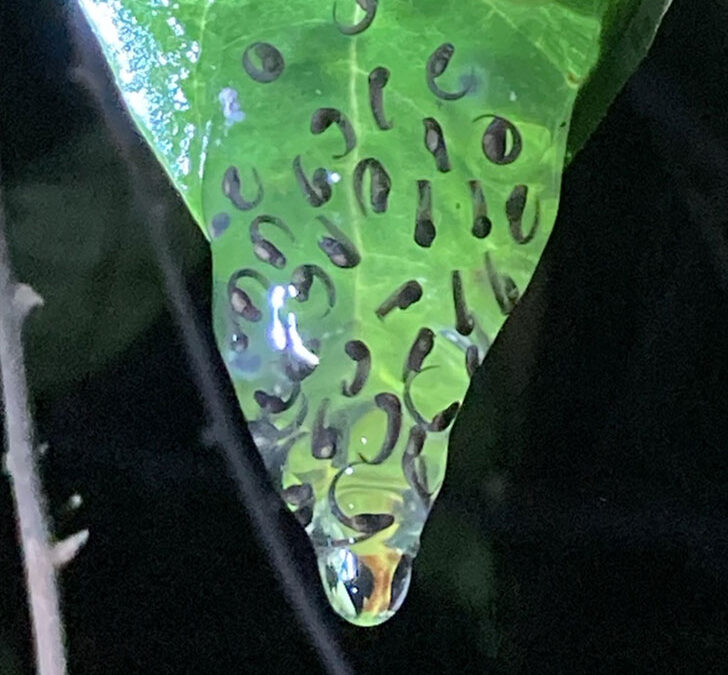On our first night in Costa Rica, we went on a night hike into the primordial jungle. Our guides gave us all flashlights before we set out, so we could all be on the lookout both for wildlife and for our safety as we hopped across a river by night. We listened for sounds and looked for sights to which our ears and eyes hadn’t previously been attuned. Being instructed about how and where to look was part of our night schooling, and it would prove to be a good introduction to our week in Costa Rica.
For instance, the photo attached to this blog is one that I took on that hike: of a water droplet on the backside of a leaf, alive with glass tadpoles working their magic of becoming frogs. I would never have known to look on the backside of that leaf if not for that evening’s lesson.
As we squelched though muddy paths, over logs and under trees, our guides were alert for sounds of pumas and other predators, as well as listening for minute sounds on the jungle floor, such as the the hard work of leaf cutter ants (see video below) working together to create a mushroom fungus for their queen ant, the safety calls between monkeys, and the mating calls of birds and frogs. All the while, ringing in my ears was Helen Oxenbury’s children’s book “We’re Going on a Bear Hunt”… You can’t go over it, you can’t go under it, you have to go through it!
Going through that walk in the dark jungle was a visceral experience. It made it impossible not to notice the interconnectedness of all things in the rich tapestry of rainforest life. Our indigenous guides were acutely aware of the biologic ecosystems connecting these plants and animals, and they expressed a deep sense of their own connection to and responsibility for how they treated all life forms. The carryover between the relationship they felt to nature and their connection to people–to one another, and to us as their guests–was refreshing.
I was struck by the gentle respect that our guides had for all living things and how that world-view translates into the contours of human relationships. They were extraordinarily patient at answering the questions of many curious visitors, and attentive to the flow of conversations in ways that in my experience many people often do not take the time to consider. They were inclusive of everyone who showed up to a night of salsa dancing they hosted during our week, regardless of our levels of dancing experience. On our penultimate day, we undertook a challenging canyoneering-trip–and even in this activity, our guides were kind and understanding about my inexperience, and balanced it carefully with some eager and overly ambitious children who didn’t always appreciate the dangerous nature of the activities and the necessary safety skills required when approaching a new task like rappelling.
When restructuring families (human ecosystems), it is often difficult for people to resist superimposing their old mental models onto their new familial and co-parenting relationships. So often deeply-established patterns are seen as immutable, when in reality they are a series of interactions which have become habitual (“our natural habitat”, perhaps?). The history of those interactions can make it challenging to reframe relationships, but by recognizing the fragile nature of relationships, human ecosystems can be carefully rethought, re-envisioned, and reformed.

